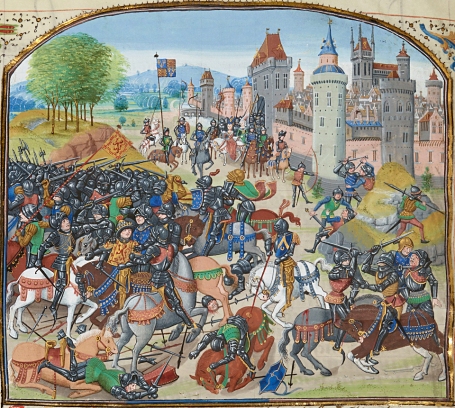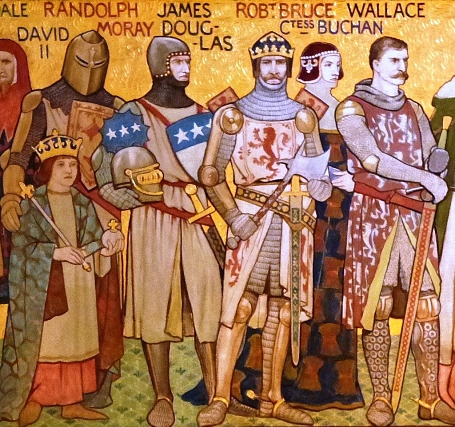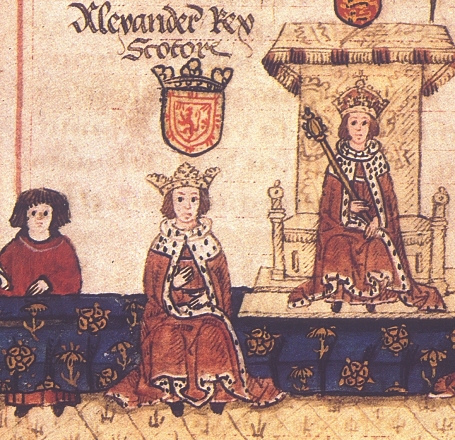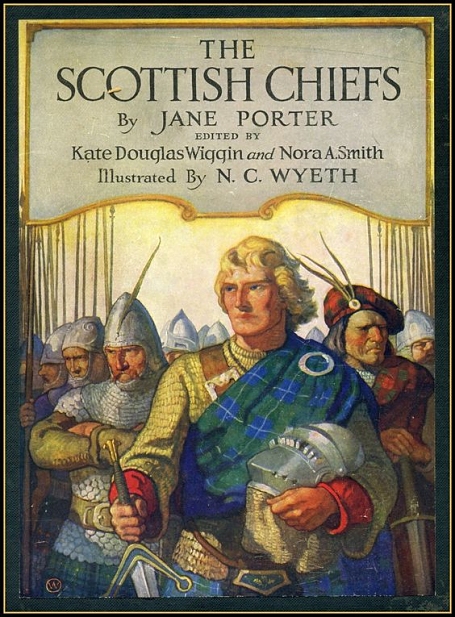The Life and Heroick Actions of the Renoun'd Sir William Wallace,
General and Governour of Scotland
by William Hamilton of Gilbertfield
Book I, Chapter II
How King Edward and Corspatrick came to Scoon and deposed the Baliol.
King Edward and Corspatrick march for Scoon,
And Scotland now sings a most mournful Tune.
Few Scots were left, the Kingdom to defend,
Then for the Baliol to Montrose they send:
And to their great and everlasting Shame,
Do strip him of his Royal Diademe.
When thus depos'd, Edward usurps the Crown,
And then Alas, all Things went upside down.
Was Crown'd upon the very self same Stone,
Gathelius sent from Spain with his own Son.
When Iber Scot first into Scotland came;
Kenneth our King, and second of that Name,
Brought it to Scoon, where Kings in Pomp and Glore,
Were crowned for Eight hundred Years and more.
Ev'n in that Ancient, Royal, Marble Chair,
So Famous, and so long, preserved there.
Which, as a Trophee, thence they do transport,
To London where King Edward keep'd his Court.
But yet I'm told that Ancient Fates decree,
Where this Stone stands, Scots shall the Masters be.
Bruce, with Eight score the Flow'r of Scotland then,
Were Captives led away, with English-Men.
At last the Pow'rs above, beheld the Wrong,
And let not the Usurper Reign too long.
For at this Time Scotland was almost lost,
And overspread with a rude South'ron Host.
Wallace his Father, to the Lennox fled,
His eldest Son he thither with him led,
The tender Mother's also gone at last,
And to Kilspindie, with young Wallace past:
Into the pleasant Carse of Gowrie, where,
He was brought up with his old Uncle there:
Who to Dundee him carefully does send,
For Education, but behold the End.
There he continues in his tender Age,
Till more adult, than does he ramp and rage,
To see the Saxon Blood in Scotland Reign,
And govern'd, by a most unrighteous King.
Who wrought great wrong in Country and in Town,
Wasted our Lands, and broke our Buildings down,
Maids, Wives, and Widows Chastity, they spill,
Nor could the Nuns resist their lustful Will.
King HEROD's Part they acted in the Land,
Upon the Children, they before them fand:
The Bishopricks that were of most avail,
From Bishops, and Arch-Bishops, they took haill.
Nor could the Pope, them with his threat'nings scar,
They gripped all, thro' violence of War.
Of ev'ry Benifice was worth their while
They took the Rents; left Bishops the bare Stile.
Our Barrons kill'd, without Remorse, or Care,
As testifie the bloody Barns of Ayr.
Where Eighteen Score were hang'd by Saxon Seed,
As in the Seventh Book you shall shortly read.
But I go on with faithful Pen and true,
And candidly my Purpose do pursue;
Wallace, tho' young as yet for Sword or Spear,
Did grieve, and groan, such Injuries to hear;
"Ah! Should my Country suffer such Distress,"
Said he, "And South'ron daily thus increase,
O had I but Ten thousand at my Back,
And were a Man, I'd gar their Curpons crack."
Yet e'r he was full Seventeen Winters old,
He was both Seemly, Strapping, Stout and Bold;
Was with the South'ron frequently at Strife,
And sometimes twinn'd them of their precious Life.
By hewing down, all grew above their Neck;
A certain token of true Scots respect.
Then, left them swelt'ring in their Blood and Gore,
A full Foot shorter than they were before.
That they to Scots might give no more Offence,
Wherewith his Priest most freely did Dispence:
Absolv'd the Sin, and did remitt the Guilt
Of South'ron Blood; so innocently spilt.
The ballad, The Life and Heroick Actions of the Renoun'd Sir William Wallace, General and Governour of Scotland, by William Hamilton of Gilbertfield, 1722, is in the public domain.

The Kingdom of England and the Kingdom of Scotland fought dozens of battles with each other. They fought typically over land, particularly Berwick-Upon-Tweed, and the Anglo-Scottish border frequently changed as a result. Read more at Wikipedia.

The First War of Scottish Independence was the initial chapter of engagements in a series of warring periods between English and Scottish forces lasting from the invasion by England in 1296 ... Read more at Wikipedia.

Edward I (1239-1307), also known as Edward Longshanks and the Hammer of the Scots, was King of England from 1272 to 1307. Read more at Wikipedia.

Digitized version of The Scottish Chiefs, by Jane Porter, a novelization published in 1921 by Charles Scribner's Sons, about William Wallace and the First Scottish War of Independence. Read online at archive.org.